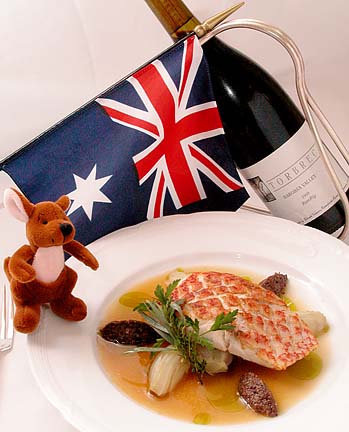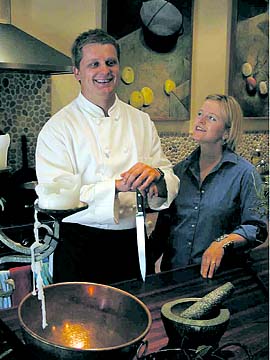


|
Pursuing the Behind us and in front of us are events that highlight foods from down under us.
elusive traits of true
Australian cuisine
To Down Under palates,
Renovation allows renewal
offal isn't awful if prepared with zestBy Betty Shimabukuro
bshimabukuro@starbulletin.comHere, on the sixth of February, we are betwixt and between a rare pair of showcases for the cuisine of Australia. Saturday was the Australia Day Ball, an annual black-tie celebration for Aussie expatriates and those who love them. Next weekend is the annual "Joy of Food and Wine" benefit for the Rehabilitation Hospital of the Pacific, which this year celebrates the joys of foods and wines from Down Under.
Cap that with a series of special meals and cooking classes at the Halekulani, featuring Sandor Palmai of Bethany, Australia, guest chef at the Rehab affair.
It's enough to make you want to throw another shrimp on the barbie. But don't. In fact, stop saying that, you Neanderthal.
Australian food has come of age. Which is to say, defining Australian cuisine has grown as impossible as defining American cuisine -- what with the sheer mass of the nations, their range of climatic zones and therefore produce, not to mention diversity of the populations.
As with this country, though, Australia had decades of undistinguished culinary history to overcome. Writer Alan Saunders, in "Australian Food: In Celebration of the New Australian Cuisine," describes his homeland back in the 1970s as "the space on the culinary map at which cartographers give up for lack of information and hand the pen over to more decorative and imaginative artists."
The two previously mentioned events -- our bookends in time -- provide contrasting views of Australian cuisine.
The Australia Day Ball exists in a bit of a time warp, its menu firmly wedded to classic dishes of another era. "The ex-pats are just that," says Marion Turney, who has been planning menus for all 11 years of the event's history. "We want it to be the way it was when we were growing up."
Australian cuisine has grown sophisticated, of international caliber, Turney says. "None of that do we reflect. We're probably dealing with the entrenched ones who left 20 or 30 years back."
On the other hand, the Rehab Foundation event, with the inclusion of Palmai, reaches for the cutting edge. With Palmai there are no classics, no must-dos, no rules. "We kind of don't pay attention to what everyone else does," he says. "We do our own thing."
This would include an annual event called "Tongue to Tail & Blood & Guts," featuring the less appreciated parts of various animals. "Offal -- used delicately and nicely," is how Palmai describes it. For example: pig ears fried in brioche crumbs with lemon zest. "That was terrific," he recalls. "Very soft, yet crunchy."
Don't expect such flavors when he cooks in Hawaii, however. Palmai and his wife and partner Amanda Palmai are preparing the Feb. 15 gourmet dinner at the Halekulani that kicks off the Rehab fund-raiser. Even at $250 a person, it's already sold out. But serious cravings for Australian food and wine still may be dealt with at the follow-up event, the Grand Wine Tasting two days later at the Sheraton Waikiki, featuring Australian food interpreted by Sheraton chef Daniel Delbrel.
For the Halekulani dinner, the Palmais are bringing Queensland mangrove crabs, which the chef describes as dark-colored with "quite imposing claws on them ... and a lovely kind of sweeter flavor than crabs have from the ocean." They'll also bring barramundi, Australia's prime game fish, to be smoked and served atop a fennel salad.
At the Hawaii Prince Hotel, where the Australian Ball was held, guests selected from among lamb, fish and vegetarian entrées, as they always have. Appetizer was Moreton Bay Spanner Crab Cakes, salad was topped with Australian blue cheese, dessert was pavlova, as it always is.
Along with some kind of lamb at dinner, the classic meringue dessert is an absolute on the menu, Turney says. One year the hotel chose to serve peach melba instead. "It's not meringue. There was an outcry." This year, the chef's first suggestion was a chocolate-macadamia torte. "I crossed it out and wrote, 'Meringue!' ... I was horrified."
Pavlova is the easy part, though, seeing as all the ingredients can be found in Hawaii. Turney's greater challenge has been importing the more elusive traditional foods.
Kangaroo tails, for example, for soup (it's a lot like oxtail soup, she says, and in Australia you can buy the tails in any supermarket). "Importing it was just impossible. The Department of Agriculture just went rigid when we mentioned it."
Moreton Bay "bugs," or rock lobsters, were served one year, courtesy of a fisherman who air-freighted them in a frozen block. "I couldn't lift it. It took three men," Turney says. "They were absolutely wonderful, but I wasn't willing to go through that much trouble again."
Turney did find farms in Texas that raise emu, which has been served smoked or peppered on salads at past galas. "Not everybody likes it. It tastes to me a bit like a rich ham and it's unbelievably expensive. People actually invest in emus. It's like buying stock."
Joy of Food and Wine
Grand Wine Tasting: 1 to 5 p.m. Feb. 17
Featuring: 200 Australian wines, plus Australian foods and wine seminars
Place: Sheraton Waikiki
Tickets: $55 in advance, $65 at the door
Call: 544-3385
Study Australian cuisine
Hands-on instruction by chef Sandor PalmaiCooking classes: 9 a.m. to 1 p.m. Feb. 17 and 18
Place: Halekulani hotel
Cost: $120, includes lunch
Call: 931-5040
Also: Orchids will feature Palmai's cuisine in a three-course dinner ($38) Feb. 16 to 23, and an executive lunch ($21 to $25) Feb. 19 to 23. Call 923-2311.
|

|
Sandor and Amanda Palmai have achieved a huge level of success by thinking small. Their Landhaus restaurant is a stone-and-mud cottage in a tiny hamlet in Barossa Valley, a prime winemaking area. Renovation allows
a renewal of tastesStar-Bulletin
The cottage is small and low -- so low that Sandor was dodging light bulbs in the kitchen. It was built in 1847, he says. "Back them I think people were much shorter."
The restaurant accommodates just 20 diners at a time, with a limited and very exclusive menu built on Sandor's bold, French provincial style that favors balance and subtlety over frills.
They invested their own money and worked the place practically alone, enamored of the idea of complete and perfect control. "The wife is out front, the husband is in the kitchen, something that you'd find in France, something like that," Sandor says.
They built an enviable reputation, "but after awhile the gloss of us doing everything ourselves kind of wore off ... also our customers couldn't get in."
So Landhaus is undergoing an expansion. It's been closed since 1999 and won't reopen until later this year, with a big 50 seats. The renovation break gives the Palmais time to travel, sampling as they go. "We shape our foods that way," Sandor says.
He'd really like to try some traditional Hawaiian food. He's had kalua pig, which was good, he says. "I had poi. I wasn't really sure about that."
Click for online
calendars and events.